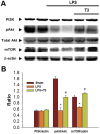Thaliporphine preserves cardiac function of endotoxemic rabbits by both directly and indirectly attenuating NFκB signaling pathway
- PMID: 22761733
- PMCID: PMC3382609
- DOI: 10.1371/journal.pone.0039174
Thaliporphine preserves cardiac function of endotoxemic rabbits by both directly and indirectly attenuating NFκB signaling pathway
Abstract
Cardiac depression in sepsis is associated with the increased morbidity and mortality. Although myofilaments damage, autonomic dysfunction, and apoptosis play roles in sepsis-induced myocardial dysfunction, the underlying mechanism is not clear. All of these possible factors are related to NFκB signaling, which plays the main role in sepsis signaling. Thaliporphine was determined to possess anti-inflammatory and cardioprotective activity by suppressing NFκB signaling in rodents. The purpose of this study is to further prove this protective effect in larger septic animals, and try to find the underlying mechanisms. The systolic and diastolic functions were evaluated in vivo by pressure-volume analysis at different preloads. Both preload-dependent and -independent hemodynamic parameters were performed. Inflammatory factors of whole blood and serum samples were analyzed. Several sepsis-related signaling pathways were also determined at protein level. Changes detected by conductance catheter showed Thaliporphine could recover impaired left ventricular systolic function after 4 hours LPS injection. It could also reverse the LPS induced steeper EDPVR and gentler ESPVR, thus improve Ees, Ea, and PRSW. Thaliporphine may exert this protective effect by decreasing TNFα and caspase3 dependent cell apoptosis, which was consistent with the decreased serum cTnI and LDH concentration. Thaliporphine could protect sepsis-associated myocardial dysfunction in both preload-dependent and -independent ways. It may exert these protective effects by both increase of "good"-PI3K/Akt/mTOR and decrease of "bad"-p38/NFκB pathways, which followed by diminishing TNFα and caspase3 dependent cell apoptosis.
Conflict of interest statement
Figures






Similar articles
-
Thaliporphine ameliorates cardiac depression in endotoxemic rats through attenuating TLR4 signaling in the downstream of TAK-1 phosphorylation and NF-κB signaling.Naunyn Schmiedebergs Arch Pharmacol. 2010 Dec;382(5-6):441-53. doi: 10.1007/s00210-010-0562-1. Epub 2010 Sep 17. Naunyn Schmiedebergs Arch Pharmacol. 2010. PMID: 20848273
-
Salidroside suppressing LPS-induced myocardial injury by inhibiting ROS-mediated PI3K/Akt/mTOR pathway in vitro and in vivo.J Cell Mol Med. 2017 Dec;21(12):3178-3189. doi: 10.1111/jcmm.12871. Epub 2017 Sep 14. J Cell Mol Med. 2017. PMID: 28905500 Free PMC article.
-
Thaliporphine increases survival rate and attenuates multiple organ injury in LPS-induced endotoxaemia.Naunyn Schmiedebergs Arch Pharmacol. 2005 Jan;371(1):34-43. doi: 10.1007/s00210-004-1014-6. Epub 2005 Jan 15. Naunyn Schmiedebergs Arch Pharmacol. 2005. PMID: 15654598
-
Resveratrol Protects the Myocardium in Sepsis by Activating the Phosphatidylinositol 3-Kinases (PI3K)/AKT/Mammalian Target of Rapamycin (mTOR) Pathway and Inhibiting the Nuclear Factor-κB (NF-κB) Signaling Pathway.Med Sci Monit. 2019 Dec 6;25:9290-9298. doi: 10.12659/MSM.918369. Med Sci Monit. 2019. PMID: 31806860 Free PMC article.
-
Acacia catechu (L.f.) Willd and Scutellaria baicalensis Georgi extracts suppress LPS-induced pro-inflammatory responses through NF-кB, MAPK, and PI3K-Akt signaling pathways in alveolar epithelial type II cells.Phytother Res. 2019 Dec;33(12):3251-3260. doi: 10.1002/ptr.6499. Epub 2019 Sep 10. Phytother Res. 2019. PMID: 31506998
Cited by
-
Anti-Apoptotic Role of Sanhuang Xiexin Decoction and Anisodamine in Endotoxemia.Front Pharmacol. 2021 Apr 21;12:531325. doi: 10.3389/fphar.2021.531325. eCollection 2021. Front Pharmacol. 2021. PMID: 33967742 Free PMC article. Review.
-
Trauma, a Matter of the Heart-Molecular Mechanism of Post-Traumatic Cardiac Dysfunction.Int J Mol Sci. 2021 Jan 13;22(2):737. doi: 10.3390/ijms22020737. Int J Mol Sci. 2021. PMID: 33450984 Free PMC article. Review.
-
TM-1-1DP exerts protective effect against myocardial ischemia reperfusion injury via AKT-eNOS pathway.Naunyn Schmiedebergs Arch Pharmacol. 2015 May;388(5):539-48. doi: 10.1007/s00210-015-1098-1. Epub 2015 Feb 13. Naunyn Schmiedebergs Arch Pharmacol. 2015. PMID: 25672911
-
Systemic and Cardiac Alterations After Long Bone Fracture.Shock. 2020 Dec;54(6):761-773. doi: 10.1097/SHK.0000000000001536. Shock. 2020. PMID: 32205793 Free PMC article.
-
Evaluation of cardiac troponin I in serum and myocardium of rabbits with experimentally induced polymicrobial sepsis.Exp Anim. 2020 Jan 29;69(1):54-61. doi: 10.1538/expanim.19-0046. Epub 2019 Aug 29. Exp Anim. 2020. PMID: 31462610 Free PMC article.
References
-
- Annane D, Bellissant E, Cavaillon JM. Septic shock. Lancet. 2005;365:63–78. - PubMed
-
- Martin GS, Mannino DM, Eaton S, Moss M. The epidemiology of sepsis in the United States from 1979 through 2000. N Engl J Med. 2003;348:1546–1554. - PubMed
-
- Hotchkiss RS, Karl IE. The pathophysiology and treatment of sepsis. N Engl J Med. 2003;348:138–150. - PubMed
-
- Poelaert J, Declerck C, Vogelaers D, Colardyn F, Visser CA. Left ventricular systolic and diastolic function in septic shock. Intensive Care Med. 1997;23:553–560. - PubMed
-
- Munt B, Jue J, Gin K, Fenwick J, Tweeddale M. Diastolic filling in human severe sepsis: an echocardiographic study. Crit Care Med. 1998;26:1829–1833. - PubMed
Publication types
MeSH terms
Substances
LinkOut - more resources
Full Text Sources
Research Materials
Miscellaneous

